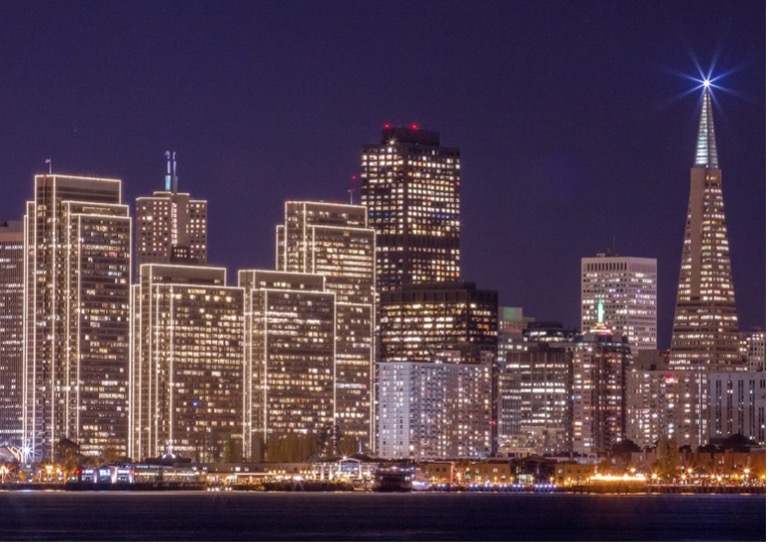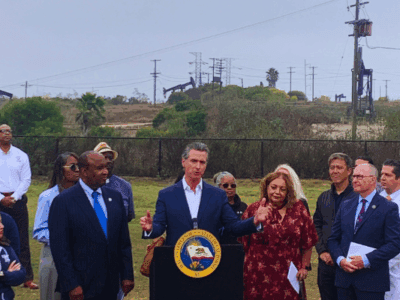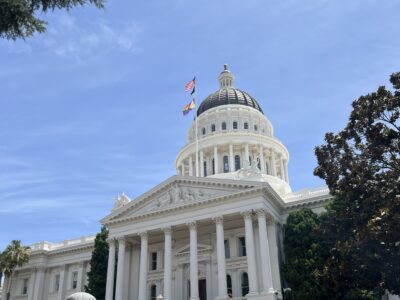Why the Bay Area’s Zero-Emission Appliance Rule is a Big Deal
BAAQMD’s trailblazing rule will ban the sale of new gas furnaces and water heaters to combat nitrogen oxide pollution. It marks a big victory for public health and the planet.

Creator: Christian Arballo
Air quality officials in the San Francisco Bay Area just made history by moving to adopt the nation’s first rules phasing out new gas-fueled water heaters and furnaces in homes and businesses within about eight years. This action serves as a major step in the effort to curb health-harming and planet-warming emissions from buildings.
Several cities in California, including Los Angeles and in the Bay Area, have outlawed new gas hookups, but these are the first regulations that would effectively ban the sale of gas appliances. Research shows that halting the burning of fossil fuels in homes and businesses is beneficial for the health of residents and vital to combat climate change. It should thus be replicated throughout the state and nation. A policy brief published by the Emmett Institute in March 2022 outlines California air districts’ legal authority to adopt these kinds of regulations and suggests policy mechanisms to help ensure the transition to electric appliances is equitable and affordable.
The Threats of Gas Appliances
Every day, domestic gas-powered building appliances emit 65 tons of toxic and highly reactive gases called nitrogen oxides (NOx) per day. That’s over four times as much as all of the gas power plants in the state combined. These chemicals can irritate airways and exacerbate respiratory diseases, according to the Bay Area Air Quality Management District (BAAQMD). Additionally, NOx react with other chemicals in the air to create other harmful pollutants, like fine particulate matter and ozone.
Gas stoves are a significant driver of childhood asthma, leaking methane even while turned off and releasing as much nationwide climate pollution each year as 500,000 cars. Furnaces and water heaters are even bigger polluters, with major contributions to outdoor air pollution in the Bay Area. According to experts at think-tank Rocky Mountain Institute (RMI), these appliances release “nearly three times as much smog-causing [NOx] pollution as all of the cars in the region, and seven times as much as all of the region’s power plants.” They also produce most of the climate pollution that derives from fuel combustion in buildings.
There have been recent revelations about the dangers of gas appliances, including research by RMI, the UCLA Fielding School of Public Health, Harvard T.H. Chan School of Public Health, and Stanford University, among others. It is now evident that gas appliances not only pose substantial risks to residents’ health, but also obstruct efforts in California, in the United States, and the world over to “secure a safe climate future.”
The Rule and Other Potential Developments
By adopting this rule, BAAQMD is exercising its legal authority under both federal and state law to regulate nitrogen oxides. The rule would ban most new gas water heaters (in new construction and replacements in homes) after 2027, gas furnaces after 2029, and large gas water heaters (in apartments and commercial buildings) after 2031. The phaseout would apply throughout the air district’s territory and is expected to cut more than 3,000 tons of NOx emissions each year. It is also projected to prevent 85 early deaths, thousands of asthma attacks, and lost school and workdays annually, with the greatest benefits to low-income communities and communities of color that are hardest hit by air pollution.
The rules do not apply to other appliances, like gas stoves or clothes dryers, which release far less pollution than water heaters and furnaces. Richard Trumka Jr., a member of the Consumer Product Safety Commission (CPSC), ignited debate around banning gas-burning stoves when he raised it as an option to address the risks of gas appliances. Although the CPSC clarified that a ban was not in the works, the agency voted earlier this month to seek public input on the dangers of gas stoves. Such a Request for Information could be a potential first step toward implementing safety standards or other regulations governing their use.
Meanwhile, the California Air Resources Board adopted plans last year to phase out gas water heaters and furnaces statewide by 2030 but will not consider setting regulations to do so until 2025. In the Los Angeles Basin, where ozone pollution is the worst in the nation, the South Coast Air Quality Management District is also years behind. Regulators there and beyond are watching the Bay Area closely.

Obstacles Associated with the Rule
While this rule will have great benefits for the climate and health, it is not without controversy. Several hundred speakers attended BAAQMD’s hearing both in-person and on Zoom to deliver public comment after public comment, much of it in support. Speakers representing the California Air Resources Board and a variety of public health and environmental advocacy groups cheered the proposal.
Businesses, manufacturers, and the construction industry have requested delays and other changes to the rules and question the feasibility of the phaseout given the limited availability of heat pumps and wiring as well as air flow requirements that complicate installations in older homes. However, the proposal includes four to eight years of lead time for each of the rule components before it begins to take effect. The rules will send an important signal to contractors and manufacturers regarding the demand, while providing them time to build capacity.
Opponents also argue it would place a large financial burden on many households that could not afford it. There are serious equity barriers around building electrification that elected officials in the Bay Area, Southern California, and other parts of the state will have to work hard to address in order to ensure the transition is successful.
The largest hurdle is up-front cost; electric appliances still cost more than gas ones. According to BAAQMD, installing a new heat pump costs about $2,900 more than a gas furnace, and a heat-pump water heater costs an average of $850 more than a gas one. However, they could be offset by cost savings, including reduced tax credits and utility bills, rebates, and other federal climate incentives that are becoming available under the federal Inflation Reduction Act, in addition to state programs designed for low-income households. An analysis by SPUR, a nonprofit public policy organization, found that replacing gas furnaces and water heaters with heat pumps could actually result in $8,000 in cost savings with existing state and federal subsidies.
Now that the rules have passed, the air officials will initiate a stakeholder working group to make sure that market actors are creating the conditions necessary for equitable and affordable implementation by the planned dates. Two years before the rules take effect, staff will also evaluate market readiness and whether equitable implementation is feasible, and adjust accordingly. These safeguards will help ensure that low-income households will indeed reap the benefits of clean-fueled appliances.
Conclusion
With its rule adoption, the Bay Area is leading the state on environmental innovation. It is imperative that California and air districts throughout the state follow suit and swiftly address the harms from gas appliances. A switch to zero-emitting heat pumps from gas appliances in California would result in 350 fewer deaths and 900 fewer cases of respiratory illnesses, while saving $3.5 billion in health costs per year. This transition will not happen overnight. Appliances can last for at least 20 years, and it will take decades for the Bay Area’s 1.8 million households that currently use gas-fueled appliances to switch them out. But the Bay Area’s groundbreaking rule marks a significant move in the right direction.
Reader Comments
3 Replies to “Why the Bay Area’s Zero-Emission Appliance Rule is a Big Deal”
Comments are closed.







It’s unfortunate that you decided to omit the fact that only 6% of the NOx in our air comes from gas fired home appliances. The NOx emissions from cars were reduced by technology beginning in the late 60s, and that technology has only improved since then. Were the members of the air district aware of the different sources of NOx in the Bay Area and the innovative tech available to reduce these emissions. Maybe, but they might have been blinded by contributions from the true high volume producers of these pollutants.
This ruling, coming on the heels of the economically destructive Covid-19 lockdowns, is certain to put more people on the street, cause landlords to raise rents to astronomical levels, and to add to the mass exodus from the Bay Area taking place as I write this.
As you advocate for putting all our energy “eggs” in one basket, try to remember that it will only take one event, be it natural like a solar flare or man made like an EMP weapon, to put us all back to the stone age. I’ll bet those wood fires we will have to use to stay warm will be really good for the air.
The article states, “Every day, domestic gas-powered building appliances emit 65 tons of toxic and highly reactive gases called nitrogen oxides (NOx) per day. That’s over four times as much as all of the gas power plants in the state combined.” It sounds like you are refuting this claim? Can provide a link to the emissions inventory from which you claim that “only 6% of the NOx in our air comes from gas fired home appliances”? Thanks.
So ,just wanted to know if all the gas fired electric generators powerplants will also be converted to electrical option ? That might sound funny or stupid , but I’m sure other people will like to know
I remember when those who decided to built the one in Hayward about 10 years ago were all jumping and congratulating each other for the great idea , NOW WHAT ?